The Opera Garnier Guided Tour
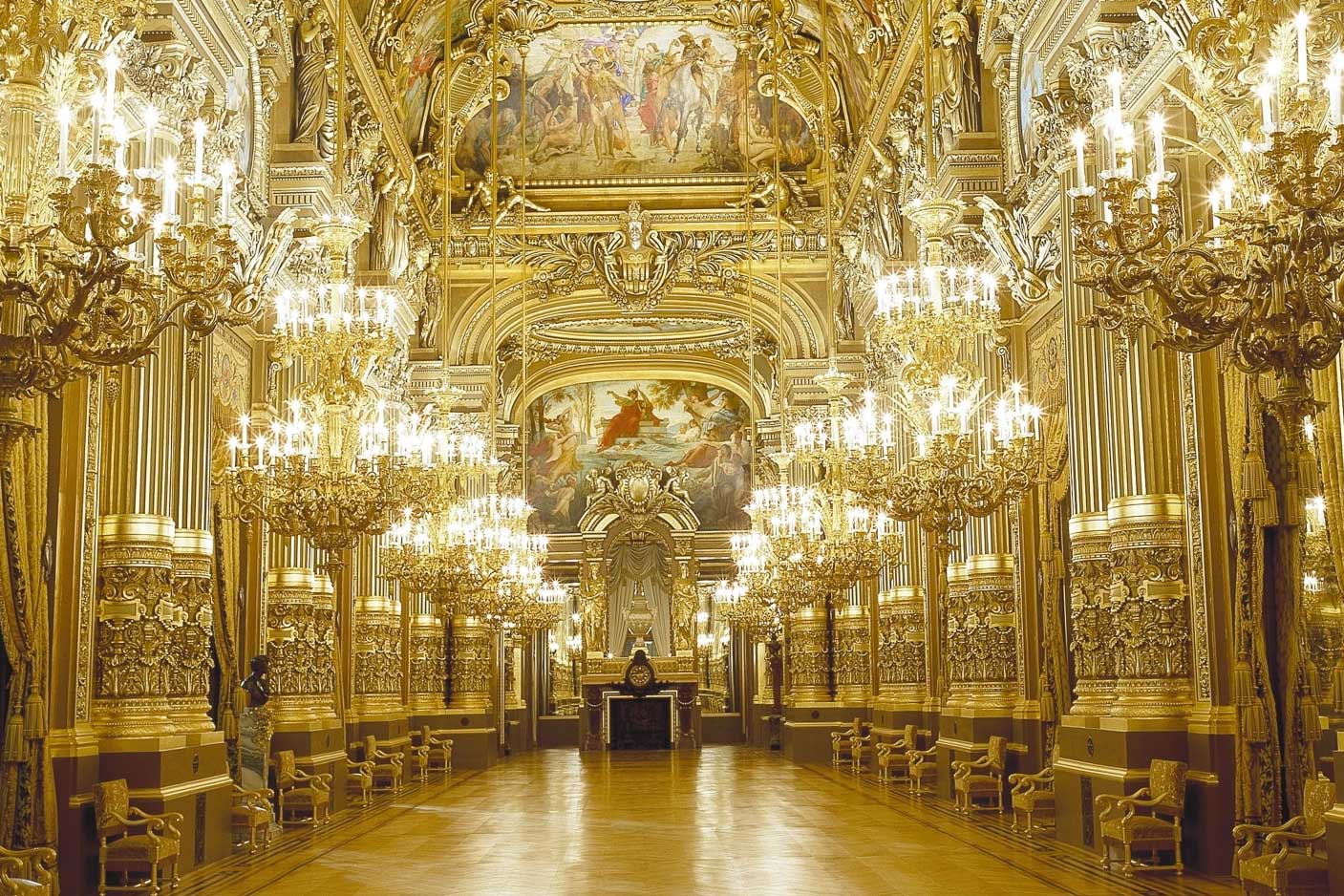
- Information
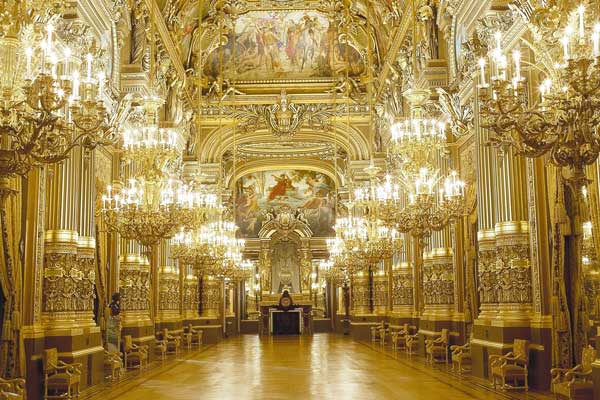
Theatre tour
Recommended for all ages
In French or English

Highlights: The Opera Garnier Guided Tour
Welcome to the most prestigious opera and ballet house in all of Paris! Book a tour with a professional guide to discover the historical and architectural wonders of the ornate Palais Garnier. Should you choose to visit the Opéra Garnier at 5 p.m., after its doors are shut to the public, your guide will take you on a journey following the footsteps of Erik – the famed Phantom of the Opera from Gaston Leroux's novel! Visit the Palais Garnier to uncover the secrets and myths of this palace that seems to transcend time itself…
Story: The Opera Garnier Guided Tour
Built in 1875 by architect Charles Garnier, the Palais Garnier is the largest opera house in Europe, housing more than 2,000 seats under its elaborate roof. As well as being regarded as the most prestigious of Paris' theatres, the Opéra Garnier is also one of the capital's most emblematic monuments, a museum in its own right with a spectacular selection of paintings, sculptures, and fascinating architectural features.
Your tour begins at the Rotonde des Abonnés, a glorious vestibule which once served as the audience entrance. Your guide will then lead you to the fascinating statue of the Pythia, and then to the Grand Escalier - a lavish split staircase with grandiose decor, featuring marble, onyx, copper, paintings, gilding, and mosaics. At its summit, you will then reach the Grand Foyer. You may find that its splendor and captivating use of mirrors and windows are reminiscent of the Hall of Mirrors at the Château de Versailles. Technical and artistic conditions permitting, you will also have access to the auditorium.
To make your visit to the Paris opera an exquisitely unique experience, you can choose to visit in the evening (5 p.m.), after the Palais Garnier is closed to the public. Your guide will take you on a tour in the footsteps of the Phantom of the Opera, the titular character from the celebrated novel by Gaston Leroux. As you discover the secrets and anecdotes of this historically and culturally rich palace, you will enjoy the rare privilege of having the entire monument to yourself, and exclusive access to the dressing room number 5 – that of the ghost himself. This tour offers you a rare opportunity to learn all of the facts and secrets about Paris' most revered (and most mysterious!) monument from an insider's perspective. What are you waiting for…?
Book a guided tour for your group of 10+ people!
Fancy sharing your trip to the Opera de Paris with friends? Look no further - Theatre in Paris offers guided group tours of this architectural relic! Indulge in an unparalleled journey through time with your closest companions and marvel as the secrets and surprises of this enchanting edifice unfold before your very eyes… a beautiful experience to share with friends and family. Enjoy reduced rates for larger groups - get in touch!
Contact us at [email protected] to make your reservation! If you are interested in booking for a group of 10 or more people , we ask that you please book at least 45 days in advance . For groups of any size, we strongly recommend booking in advance of your desired dates to guarantee your place. We’ll see you there…!
There are not yet any reviews for this show, be the very first to share a review by completing the following:
Opéra Palais Garnier
One of the most prestigious stages in all of France, the Palais Garnier was constructed between 1860 and 1875, designed by legendary architect Charles Garnier, who was selected among a handful of talented architects in a fierce design competition. The building itself is considered an artful masterpiece, and was one of the most expensive construction projects to come from the Second French Empire under the reign of Napoléon III. The elaborate use of different materials to lend a lavish multicolored facade was typical of many of the works under the rule of Napoléon III, and features sculptures of various figures of Greek mythology. The official inauguration in 1875 was attended by the Mayor of London and Amsterdam, the King Alphonso XII of Spain, and hundreds of members from European high society.
The interior was meticulously designed with intertwining corridors, alcoves and landings to allow for easy movement of large numbers of people; complete with a grand marble staircase and the grand foyer, acting as the drawing room for all of Paris high society and covered in gilded paintings. The auditorium itself is in a traditional Italian horseshoe shape, seating 1900. The stage is the largest in Europe and can accommodate 450 artists, revealed by the opening of the legendary painted curtain. Garnier himself designed the 7-tonne chandelier sparkling above the audience. In 1896, one of the many chandelier counterweights broke free and killed a concierge, the incident that inspired the scenes in the 1910 novel-turned-musical The Phantom of the Opera . The space above the auditorium in the copula dome was once used strictly for cleaning the chandelier, but has since been transformed into a space for opera and dance rehearsals.
The legendary building was initially deemed the Academie Impériale de Musique, yet with the fall of the Second Empire and the start of the Third Republic, this was aptly changed for the Academie Nationale de Musique, which we see written across the exterior facade to this day. Garnier envisioned his design and the transformation of the surrounding area, and to this day the opulence of the Second Empire lives on in this living monument. The avenue de l'Opéra remains the only large Parisian corridor without trees, as Garnier explicitly prevented Haussmann from adorning the street with trees, arguing that his Palais Garnier was to be the main focus. Palais Garnier became the official name in 1989 with the construction of the Opéra Bastille, and the venue now houses primarily ballets.
Fast facts Capacity: 1,979 Handicap Accessible: Yes – in order to guarantee access to specific locations, we ask that you make your reservation at least 15 days before the performance. Air conditioning: Yes Heating: Yes Coat Check: Yes (free service)

How do I get to the venue?
The Palais Garnier is accessible by the metro station Opéra (Lines 3, 7, 8) and Auber (RER Line A). Our hotline can be reached in case of difficulty finding the venue weekdays from 10 am to 7pm Paris time. For details, we invite you to consult the map above.
What do I do when I get to the venue?
We invite you to arrive 30 minutes before the beginning of the tour. Once you have entered the building, the meeting point with your guide is located at the Rotonde des Abonnés. Please present your voucher to the guide upon your arrival.
How long does the tour last?
The guided tour of the Palais Garnier Opera House lasts 1 hour 20 minutes.
Is it a guided tour of the Palais Garnier for tourists or French people?
Both! The Palais Garnier is an iconic monument of Paris, visited as much by travelers as by the local public. Tours are offered in French or English, usually at different times. The language is indicated in the price list after you select a day and time to visit when you make your reservation, so be sure to check your choice.
Is it possible to visit the theatre and backstage?
Visitor's Guide to the Opera Garnier in Paris
19th-Century Historic Building
:max_bytes(150000):strip_icc():format(webp)/profilepic-CTraub-5b6ff65d46e0fb00505577c1.jpg)
TripSavvy / Taylor McIntyre
Seating 2,200 people, the imposing Opera Garnier in Paris —also known as the Palais Garnier or simply the Paris Opera—is an architectural treasure and essential spot for the city's ballet and classical music scene.
Designed by Charles Garnier and inaugurated in 1875 as the Academie Nationale de Musique—Theatre de l'Opera (National Academy of Music–Opera Theater)—the neo-baroque style Opera Garnier is now the home of the Paris ballet. This does create some confusion for many tourists (ballet in the opera theater).
For anyone hoping to enjoy a Parisian Opera rendition of La Traviata or Mozart's The Magic Flute, the city's official opera company relocated to the starkly contemporary Opera Bastille in 1989.
Location and Contact Information
The Palais Garnier is located in Paris's relatively central 9th arrondissement, more or less directly north of the Tuileries Gardens and the adjoining Louvre Museum. It's one of the crowning attractions of the Opera-Haussmann neighborhood; one of Paris's most coveted shopping districts and the hub of major department stores like Galeries Lafayette and Printemps.
To make a morning or afternoon of it, you can visit the Opera, take a stroll around the old department stores, and have lunch in one of the gorgeous old 1900 brasseries in the vicinity (such as Cafe de la Paix, right across from the Opera). Then wander through the grand old streets in the vicinity—an area that's considered one of the crowning jewels of Haussmann's remodeled Paris.
- Address: 1, place de l'Opera, 9th arrondissement
- Metro: Opera, Pyramides or Havre-Caumartin
- Website : https://www.operadeparis.fr/en
Access, Opening Hours, and Tickets
Visitors can tour the main premises of the Opera Garnier during the day and visit the site's museum, either on an individual basis or as part of a guided tour.
Opening Hours
10 a.m. to 4:30 p.m. (September 10th to July 15th); 10 a.m. to 5:30 p.m. (July 15th to September 10th). Closed January 1st, May 1st. The cashier closes 30 minutes before the official closing time.
Ticket prices for ballet and other performances vary. Current performances at the Opera Garnier change so be sure to check to see what is upcoming.
Food and Dining
A recently opened restaurant situated on the Palais Garnier's eastern side (simply called "L'Opera") offers good-quality cuisine for breakfast, lunch, or dinner. Fixed-price menus are available at limited times.
Like This? Read These Related Features
Make sure to read our complete guide to Paris for music lovers , which gives you an excellent overview of the city's best venues, annual festivals, and more.
Music fans of all persuasions will love the Philharmonie de Paris, the latest newcomer to the city's art landscape and offering an eclectic program of musical performances, from classical to the world to rock. Meanwhile, if you want to enjoy contemporary opera in Paris, check out the boldly modern charms of the Opera Bastille.
Finally, for traditional French "chansons," dance, and late-night reveries check out our guide to the best traditional cabarets in Paris, from the Moulin Rouge to more avant-garde (and less expensive) revues like the Zebre de Belleville.
Top 15 Monuments and Historic Sites in Paris
All About the Jardin des Tuileries in Paris
Top 15 Things to Do at Night in Paris
Taking the Roissybus to or From Charles de Gaulle Airport
Luxury Shopping in Paris Boutiques and Stores
9 Places for Jewish History in Paris, From Museums to Memorials
A Self-Guided Tour of Parisian Architecture
May Events in Paris: Festivals, Sports & More
All About the Yves Saint Laurent Museum in Paris
Review of Context Travel Walking Tour: The Making of Modern Paris
Les Invalides in Paris: The Complete Guide
The 7 Best Places for Shopping in Paris
18 Best Free Things to Do in Paris
The Top 15 Things to Do in Bordeaux, France
Paris for Music Lovers: A Complete Guide to Venues and Festivals
Fragonard Perfume Museum in Paris
Visit The Palais Garnier
Almost 150 years old and classified as a historical monument since 1923, discover a dazzling and unrivaled place, in the very center of Paris: the Palais Garnier.
Discover a unique and prestigious place in the heart of Paris
Individual rates.
23.00 €
16.50 €
Reduced Rate*
Under 10 years
10.00 €
26.00 €
Single rate for visits after closing
Free for children under 4 and accompanying disabled people. *Under 25s, disabled people, seniors (over 65s), jobseekers, students.
Several tours are available. Consult our tour descriptions to book the time slot corresponding to the tour of your choice.
Group rates, click here
Practical information
Doors open at 10am. Please arrive 30 minutes before your scheduled visit.
Luggage is not accepted on the site and no left luggage is available for security reasons. Scooters, rollerblades, skateboards and electric scooters are strictly forbidden in the Palais Garnier.
Mystery visits: The visit is not accessible to people with reduced mobility after 5 pm.
Access to the auditorium may be impossible for reasons beyond our control.
Discover the world's most beautiful opera house on one of our guided tours
Discover a unique and prestigious place in the heart of paris: the palais garnier. several visits are to be discovered: intermezzo visit to the palais garnier: through the rooms of the opera accessible to the public, discover the extraordinary history of the palais garnier, a monument of architecture and a total work of art. length of visit: 1 h 30 - (any time slot other than belle époque). visit palais garnier in the belle epoque: go back in time with charles garnier, experience the atmosphere of the temple of social life in the 19th century, let yourself be transported and join the dance length of visit: 1 h 30 - (usually between 11 h 30 and 15 h 30). visit the mysteries of the palais garnier (after closing): discover all the secrets of the paris opera in this visit outside opening hours to the general public. in a cozy atmosphere, discover or rediscover a timeless place. length of visit: 1h15 - (after 5pm closing time)., the palais garnier: a hymn to magic.
Initiated by Napoleon III after an attempted attack and inaugurated in January 1875, it was after 15 years of work carried out by Charles Garnier, an architect unknown at the time, that the Palais Garnier was born. Today, this building, also called Opéra Garnier is one of the most emblematic monuments of the 9th arrondissement.
Spread over an area of 11,000 m², this eclectic style building will charm you with its many influences: Louvre Museum, Palace of Versailles...
Enter the largest opera house in France and enjoy its famous grand staircase, the Bassin de la Pythie or its sumptuous grand foyer and lounges.
Also discover...

Printemps Haussmann
See all tours in île de france.

La Défense district
See all culture tours, how to get to the palais garnier, address palais garnier 1 rue auber 75009 paris access metro: opera / chaussée d'antin (l3 / l7 / l8) rer: auber bus: 20, 21, 22, 27, 29, 42, 52, 53, 66, 68, 81, 95 parking: haussmann galeries lafayette 75009 paris , explorez l'opéra garnier avec vos élèves grâce à nos visites guidées , visite scolaire cycle 1 : .
Conçue pour les élèves de maternelle entre 3 et 6 ans, cette visite scolaire de Cycle 1 permettra à vos élèves de découvrir le Palais Garnier par une expérience sensorielle riche, en plaçant l’observation au centre de la visite. Celle-ci leur apprendra à mobiliser le langage en les poussant à mettre des mots sur leurs émotions, leurs sentiments et leurs impressions. Des mises en situation leur permettront d'apprendre et de découvrir en jouant, à travers les grandes notions en cours d’acquisition à l’école : les formes, les couleurs, les sens.
Durée de la visite : 1 h 30
Public : Petite, moyenne et grande section de maternelle (3 à 6 ans)

Visite Scolaire Cycle 2 :
À l'âge où l'apprentissage de la lecture émerge, initiez vos élèves à la musique en leur expliquant que comme un livre, la musique se lit, se joue et narre des récits envoûtants. À travers cette expérience captivante, vos élèves exploreront l'univers fascinant de l'art qui élargira leurs horizons artistiques et stimulera leur imagination. Faites découvrir à vos élèves l'univers de l'opéra et son vocabulaire riche tel que : le ballet, la salle de spectacle, la scène, la fosse d'orchestre, les chanteurs lyriques et bien plus encore. En plus de son architecture spectaculaire, explorez les œuvres picturales et sculptées du Palais Garnier qui enrichissent cet art immémorial que représente l'opéra.
Durée de la visite : 1 h 30
Public : Classes de CP, CE1, CE2
Visite Scolaire Cycle 3 :
Explorez avec vos élèves les multiples domaines de l'expression artistique à travers notre visite scolaire de cycle 3. Découvrez l'éclectisme des arts et les représentations allégoriques qui éveilleront leur curiosité et enrichiront leur compréhension du monde artistique. Au cours de cette excursion captivante, vos élèves seront initiés aux représentations allégoriques de la musique et de l'opéra, des muses inspiratrices aux cariatides symboliques de la Tragédie et de la Comédie.
Plongez dans l'histoire fascinante du Second Empire et du contexte de la construction de ce chef-d'œuvre architectural qu'est le Palais Garnier. Explorez les mythes envoûtants d'Orphée et d'Eurydice, représentés dans le Grand Escalier. Découvrez également la légende d'Apollon et d'Hermès, qui a donné naissance à la lyre, symbole intemporel de la musique. En plus de nourrir leur esprit d'histoire et de mythologie, vos élèves comprendront les notions élémentaires propres à chaque forme d'expression artistique, de l'organisation de l'espace par l'architecture à l'expression des sentiments à travers la musique.
Public : Classes de CM1, CM2, 6ᵉ
To book a school visit, please contact our reservations department:
For further...
The Arop, Association for the Outreach of the National Opera of Paris, offers you unique private tours of the Palais Garnier. The latter reveals its most secret places to you, such as the "Lac de l'Opéra", the sewing workshops or the mysterious "castans room".
The funds collected through the sale of backstage tours are used to finance the activities of the Opéra national de Paris: shows, tours, educational projects, or even the purchase of equipment for the workshops.
Find all the information by clicking here or by downloading the brochure here
And discover the Arop here: https://arop.operadeparis.fr/


A Worthwhile Guided Tour: Paris Opera House (Palais Garnier)
I much prefer taking guided tours when I travel because the learning is interactive. I often start to daydream when the self-guided audio-tour I’ve been given goes on and on and on. After a while it just becomes boring and I zone out. That’s why I especially liked taking the guided tour of the Paris Opera House (Palais Garnier), which, according to Tripadvisor, is #4 on the list of top attractions in Paris attracting almost 480,000 visitors a year.
The in-depth, expert commentary about the building’s creation, architecture, and history was one thing. But being able to ask questions and discuss things with our tour guide made the experience more meaningful and worthwhile and our tour guide really brought the building and history to life. If you’re going to do a guided tour, do it at the Palais Garnier, considered one of the world’s grandest theatres.
*This post contains affiliate links. If you make a purchase through these links, I get a small commission at no extra charge to you. It helps support the running of this website and I do appreciate your help.*
1. Palais Garnier Opera House Tour, Paris
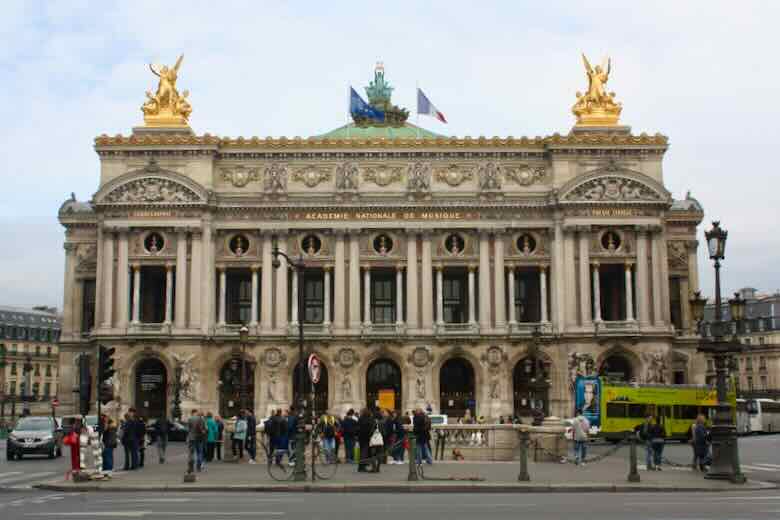
About a month before visiting the Paris Opera House, my niece, her husband, and I ordered tickets online for the guided tour. We chose one of the morning, English-speaking tours. In addition to French and English tours, there are also Spanish-speaking tours with a maximum of 30 people. The cost of the guided tour is currently 18.5 € and the self-guided visit is 14 € where you get access to the public areas and any exhibitions going on.
With the self-guided tour, you can pay an extra 6.5 € to get a tablet which will provide you with a 1 hour multi-media tour through the opera. So it’s actually quite reasonable to take the guided tour.
We arrived 30 minutes before the tour was to start to exchange our voucher for our tickets. We then had to go through security and join the other ticket-holders in a waiting area, the Rotonde des Abbonées.
Consider Booking Tickets To See A Show At The Palais Garnier : Really keen on seeing a ballet, a concert, an opera, or even demonstrations of the Paris Opera Dance School at the Palais Garnier? Check out what’s available and the best prices here: Performances At Palais Garnier .
(a) The Rotonde des Abbonées
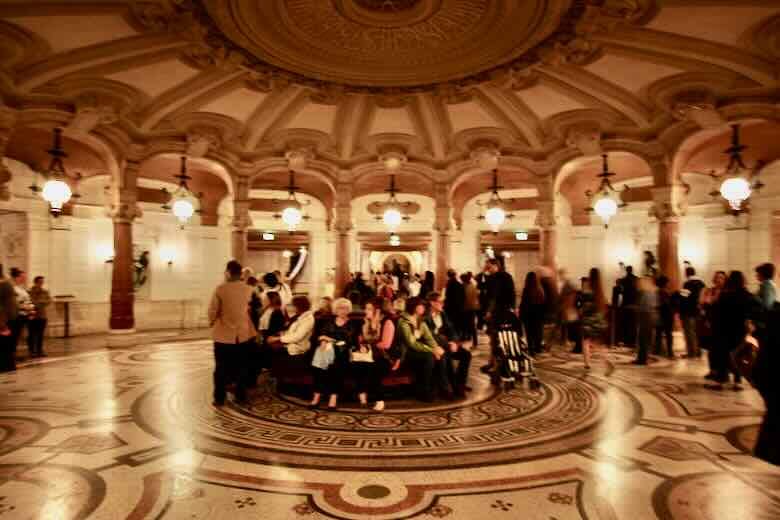
The Rotonde des Abbonées is a circular room or vestibule that has pillars on the perimeter, mosaic tiles on the floor, and a very decorative ceiling. Throughout much of the Paris Opera there are symbols of Greek mythology and as you head to the Grand Escalier (Grand Staircase) you pass by La Pythonisse (or Pythia), priestess of the god Apollo greets you.
Interesting fact #1 : the Pythia sculpture was done in bronze by Marcello who was actually a woman, Adèle d’Affry, the Duchess Castiglione-Colonna.
You might also like to read these posts: – What’s So Special About The Wallace Fountains In Paris? Free Water – Where You’ll See Famous Arches In France – Best Views Of Paris? From The Pantheon Dome
(b) Special Headphones
Our tour guide spoke excellent English and explained how the opera house can get very busy and crowded and rather than try to speak over all the voices, she would speak into a microphone and we would be able to clearly hear her using special headphones. These headsets amplified her voice but her words remained very clear. And no matter how close or far we were from her, we could hear her.
We did have to provide her with a piece of identification (ie. license or passport) that she held onto in exchange for the headphones. This is not uncommon when you borrow audio-guides at museums.
During our 90 minute tour, was informative and provided interesting commentary. Of course, she elaborated on the Phantom of the Opera and parts of the story that were true and not true. She took us to various areas and rooms and gave us time to take photos, wander around a bit, and ask questions.
2. History Of Palais Garnier
She began our tour by telling us some stories about the opera’s history. Napoleon III was on a mission to reconstruct and modernize Paris, adding sewers, creating grand boulevards and more light to the area. This was done with the help of Baron Haussmann.
A competition was established to choose a design for the new Opera House. There would be 2 phrases where applicants would be narrowed down to 7 in the 2nd phase. Architect Charles Garnier was one of 7 finalists and after revising his project, it was finally selected as the winning design. He began construction of the Opera in 1861.
The Paris Opera house was one of the most expensive buildings to be built at a cost of 7.5 million francs.
Interesting fact #2: the Opera House was so expensive that the government had to borrow over half of the money (4.9 million francs) from wealthy entrepreneur, François Blanc, who managed Monaco’s Monte Carlo Casino.
Palais Garnier was finally completed January 5, 1875. Electrical lighting was installed in 1881. Up until then gas lighting was used. The opera house was originally called Salle des Capucines but became known as the Palais Garnier, named after the architect.
Interesting fact #3 : during the construction, water kept seeping into the basement, and eventually a pond was formed and Garnier decided to create an artificial reservoir or pond to hold the water.
Interesting fact #4 : in 1896, a part of an enormous chandelier—a counterweight—broke free and fell, killing one person. In 1910, author Gaston Leroux used the area of water or “lake” of stores as well as the chandelier incident as inspiration for his famous story, Le Fantôme de l’Opéra (The Phantom of the Opera). The story and Andrew Lloyd Webber’s musical of the same name has certainly made the Palais Garnier even more famous.
The Paris Opera House is one of the largest and opulent opera houses in Europe, seating almost 2000 people. It became a national heritage site—“Monument Historique“— in 1923.
3. The Highlights Of The Palais Garnier
We were brought to various rooms and areas in the building, including the famed auditorium, where you can see the famous painting that Marc Chagall did on the ceiling. The style of the architecture throughout was eclectic with a mix of Greek, Baroque, Renaissance, and Beaux-Arts styles.
(a) Grand Escalier (Staircase)

As you climb the Grand Staircase from La Rotonde des Abbonées, you are presented with additional staircases and landings which take you to the different floors, salons, and foyers. The staircases are made primarily of white marble with additional added coloured marble columns (balustrade) supporting the railings. There are two female sculptures, dressed in robes, on each side of the entrance to the orchestra and balconies.
This whole area was for socializing before the performance. Spectators were surrounded by broad staircases, painted ceilings, and elaborate chandeliers.

Newsletter community members get access to free exclusive content like this bonus, “Top 10 Photo Locations In Paris” cheat sheet. Sign up now!
(b) Ceilings

Remember to look UP in the Opera house where ever you are because you’ll see elaborate ceilings and enormous chandeliers. The ceiling above the Grand Staircase was done in 4 panels with scenes from Greek mythology by Isidore Pils (1815-1875).
Interesting fact #5: part way through the painting of the ceiling, Pils became ill and his students (many who became famous in their own right), had to finish his work.
(c) Grand Foyer

The Grand Foyer is quite impressive and ornate. It reminds me of Château de Versaille’s Hall of Mirrors where the light streams through the many windows and illuminates the many chandeliers, gold painted pillars and walls, grand mirrors, and the colourfully decorated paintings on the ceiling by Paul-Jacques-Aimé Baudry (1828-1886).
(d) Salon du Glacier
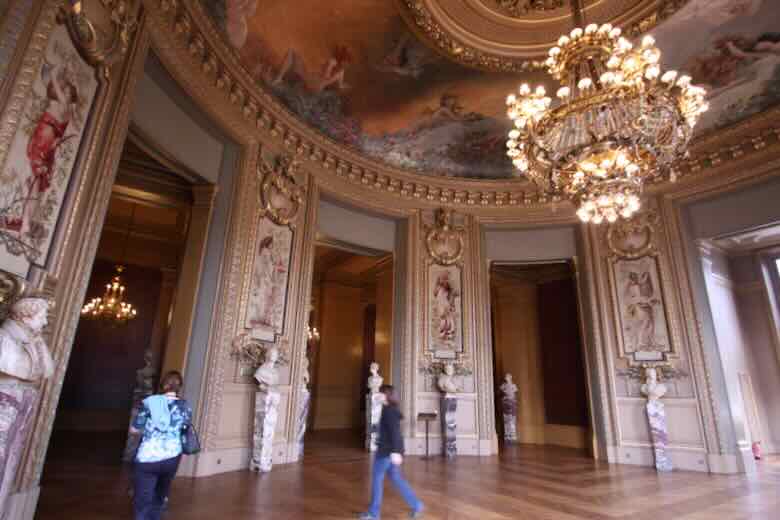
The Galleria du Glacier is a long hallway featuring elements and designs of the Belle Époque and it leads to the Salon du Glacier, a rotunda that was opened after the opening of the Opera House. It has another large chandelier and an decorated ceiling painted by Georges Clairin (1843-1919). In this area there are also marble busts, tapestries of hunting and fishing scenes and paintings of dancing Greek Bacchantes.
(e) Library-Museum Of The Paris Opera
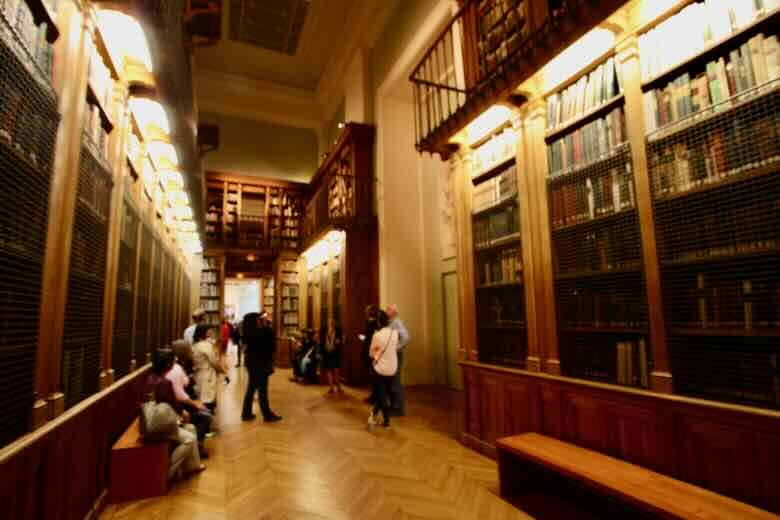
Quite surprising to many of us was that the Paris Opera is also a library-museum (Bibliotèque-Musée de l’Opera de Paris). There are many sites that belong to the Bibliothèque nationale de France (National Library of France) including the Richelieu Library which I recommend visiting so you can see the magnificent Labrouste Reading Room (the Salle Labrouste).
This particular library and museum contains hundreds of thousands of documents, paintings, photographs, letters, and other items which date back hundreds of years.
(f) Auditorium: Marc Chagall’s Painting On The Ceiling
One of the items on display in the Library-museum is actually the initial ceiling for the auditorium. It was painted by Jules-Eugene Lenepveu and was called, “The Muses and the Hours of the Day and Night”.
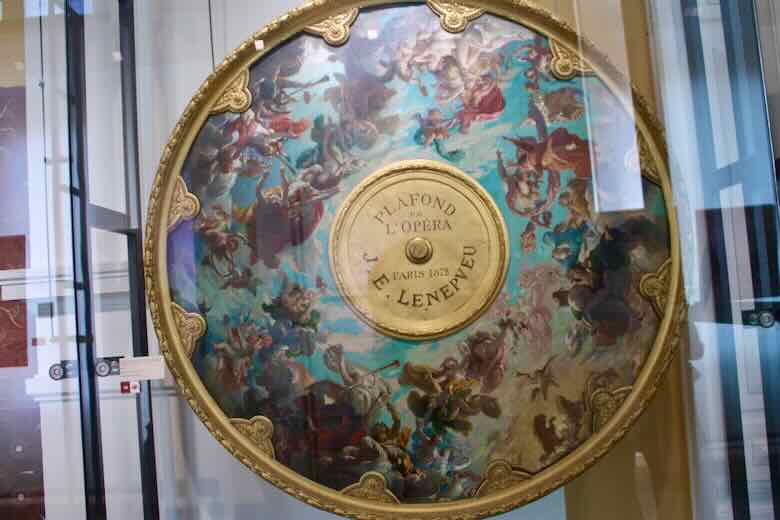
Interesting fact #6: Lenepveu’s painting was considered too old-fashioned and in 1964, French Culture Minister, André Malraux, commissioned artists Marc Chagall to paint a new ceiling. This is the painting that is there today; however, there continues to be controversy about the painting and whether it is appropriate for its surroundings, where many consider it too modern.
The chandelier in the centre has 340 lights, weighs 8 tons, and is made of bronze and crystal. At the time it cost 30,000 francs. Even the chandelier had controversy. There were complaints that the chandelier obstructed the view and Lenepveu’s painting of the ceiling by those sitting in the box seats on the fourth level.
There is NO guarantee that you will have access to the auditorium on the self-guided or guided tours as there could be rehearsals going on. We were fortunate to be able to visit it and sit on the very plush seats.
Our tour also allowed us to “peak” into one of the opera boxes) which are located on the side or facing the stage called loge de côté and loges de face)—-a separate room where 4-6 guests can watch a performance in the privacy of their own “space”. You might also be able to visit box #5, which is the Phantom’s box in the story. The plaque on the door, “Loge du Fantôme de l’Opera” indicates the box is reserved for the Phantom.
4. Attend A Performance At The Paris Opera House
We didn’t really have much time to gaze around the horseshoe-shaped auditorium; however, many years before this tour, I did attend a ballet with a friend.
When we arrived at the Opera, we couldn’t get a ticket for a tour, but we could get last-minute tickets to see a performance by the American Ballet, so we bought tickets. Our box was very high up and we had it all to ourselves. I will be very honest and say I had to leave early. It was in the summertime and the heat was just too much. (Remember, hot air rises!) I was getting faint! It was a long time ago and there wasn’t air conditioning.
Does the Palais Garnier have air conditioning today? I have heard yes, however, if you are on one of the highest levels it can still get stuffy and hot in those boxes. The only downside of seeing the ballet was that we didn’t really get to see all the salons, rooms, and areas of the Opera House, which is why I did the tour many years later.
5. The “Other” Opera House: Opera Bastille
There is another opera house in Paris. In 1989 the Opera Bastille was constructed and is located at Place de la Bastille. This is now the location for operas. Palais Garnier is primarily used for ballet performances.
Between 1994 and 2007 major renovations were made on the Palais Garnier to modernize the stage, improve the electrical components, and reinforce the structure and foundation. The architecture is stunning and the Opera House Paris tour is well worth the 18.5€ . On the Palais Garnier website you can see that their calendar indicates the number of available spots on the tour and quite often many are available.
6. Paris Opera House (Palais Garnier)
- Visit The Palais Garnier (website) : https://www.operadeparis.fr/en/visits/palais-garnier
- Hours: open daily 10:00-5:00 (and 10-6 pm in the summer) except for afternoons when there are performances
- Most guided tours: are at 2:00 pm.
- Cost for the guided tour tickets : 18.5€*
- Reduced rate: if you have a ticket from the Musée d’Orsay or Musée Gustave Moreau that is not greater than 8 days old you can save a few Euros on the cost of your ticket.
- To check out what shows you can see and the best prices, click here : Performances At Palais Garnier .
- Address : Place de l’Opera
*Prices are subject to change.
Check out my post about booking tours in advance for more information: Trip Advice Part 1
TRAVEL RESOURCES Booking.com and Expedia : are the companies I use for finding accommodations. VRBO : is super for booking apartments and houses. AutoEurope : is the only car rental supplier that I will use–with the best prices, and they will refund the difference if the price goes down. Trainline : offers an easy way to book train tickets. Get Your Guide and Viator : Both offer tours, city cards, tickets, airport pickups, and so many other things you’ll need at your destination. Orange SIM Card -this is the company I use when I want a physical SIM card Airalo eSIM -offers eSIMS and get great reviews
Pin to your favourite board on Pinterest
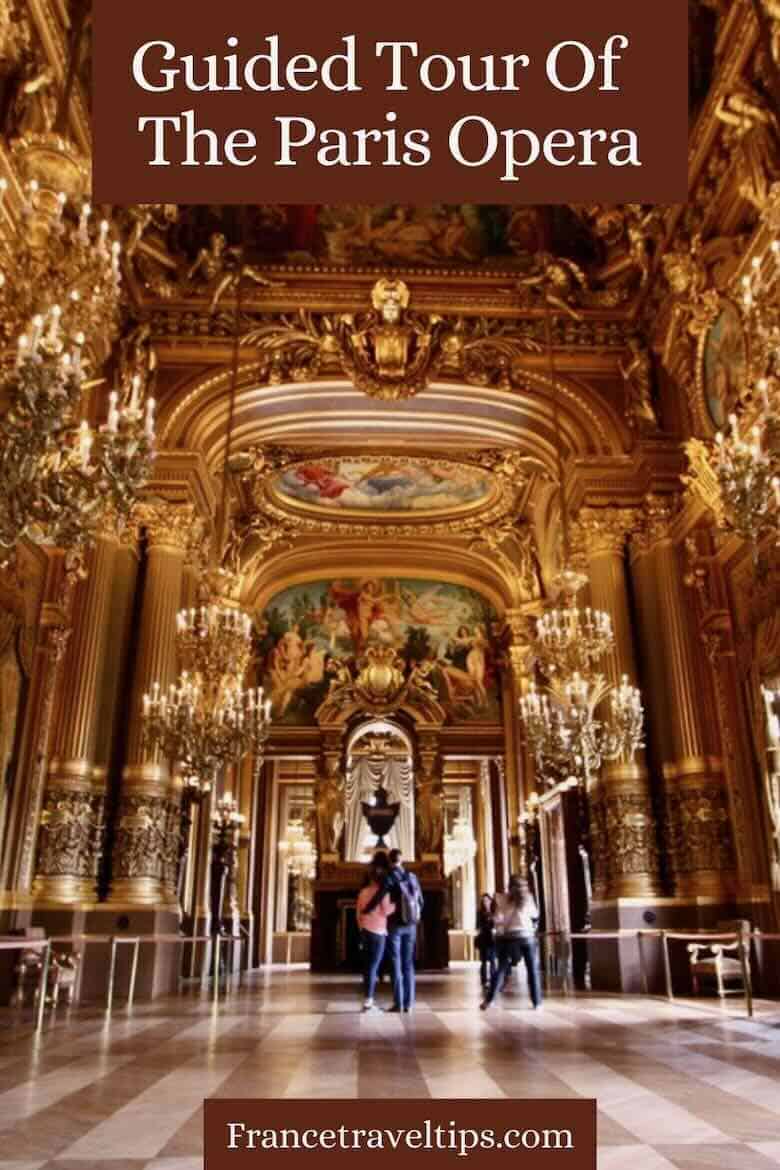
Share this post:
I've travelled to France over 35 times and love sharing my tips and unique experiences not always mentioned in travel guides. You can learn more about me by visiting my About Page . Subscribe to join my newsletter. Community members get access to free exclusive content and bonuses.
Similar Posts

6 Best Photo Locations Around Cassis
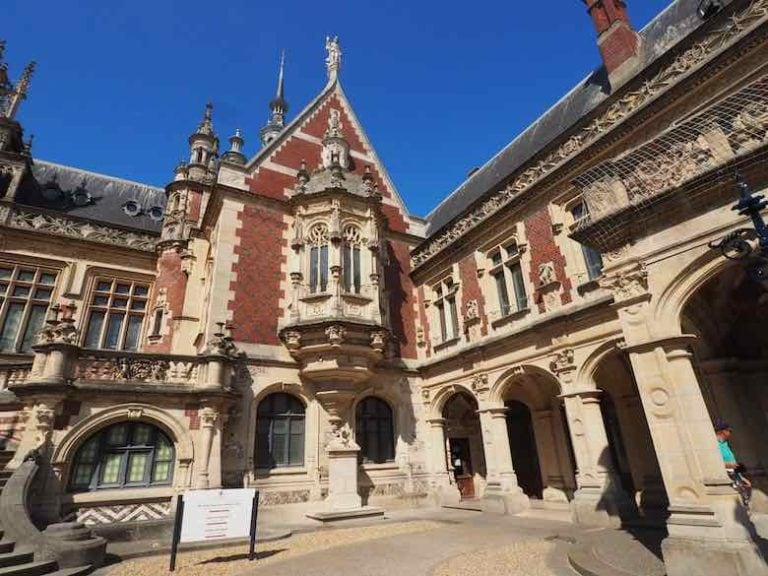

Tour And Tasting At Palais Bénédictine In Fécamp
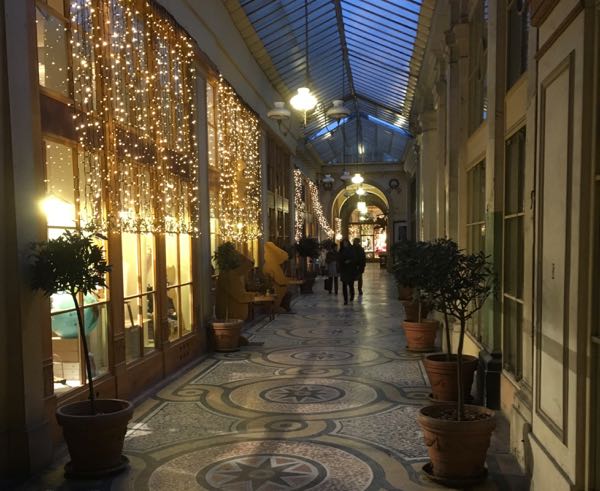
Beautiful Covered Passages-Les Passages Couverts In Paris
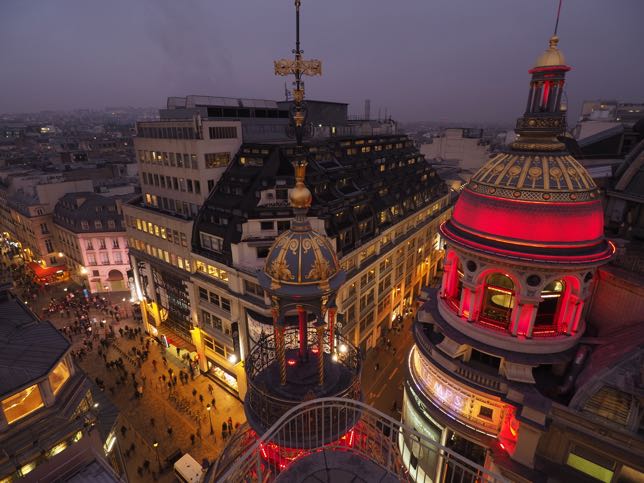
Best Views Of Paris At Night: 7 Perfect Locations
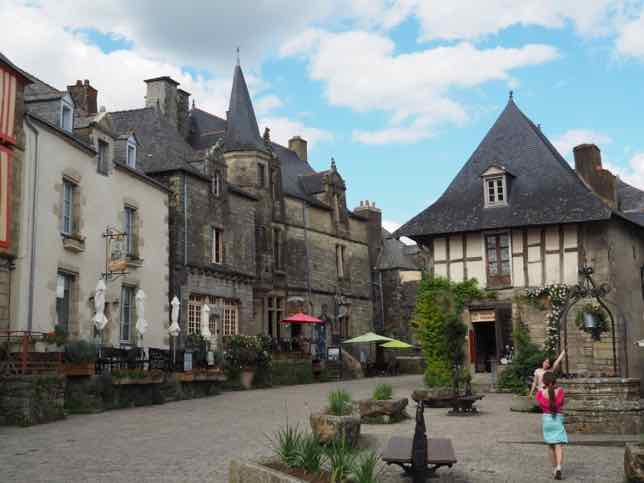
6 Days In Brittany
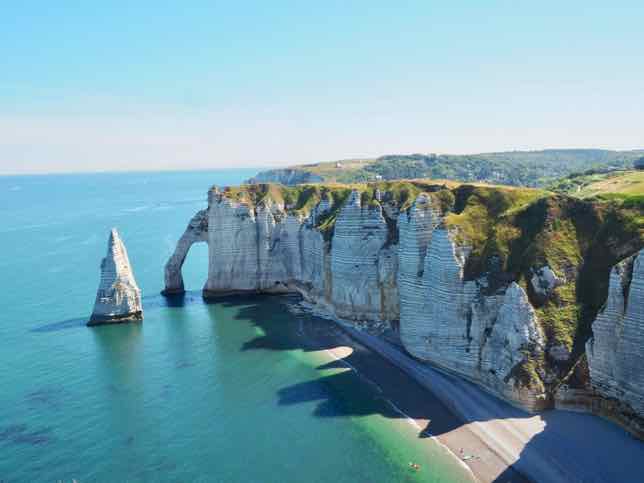
Two Of The Best Ways To See The Cliffs At Etretat
Leave a reply cancel reply.
Your email address will not be published. Required fields are marked *

- Cultural & Theme Tours
- Cultural Tours

After-Hours Tour: Opera Garnier in Paris
- Exclusive after-hours tour of the Opera Garnier in Paris
- Explore the opera house's magnificent interior without the crowds
- Admire opulent chandeliers, paintings and mirrors in the Grand Foyer and Members' Rotunda
- Visit the lavish 2,000-seat auditorium, making this one of Europe's largest opera houses
- Hear about famous operas that have played here, like La Traviata, as well as the inspiration for The Phantom of the Opera
Inclusions & Exclusions
- Entrance fee for after-hours access
- Professional guide
- Food and drinks
- Gratuities (optional)
- Hotel pickup and drop-off
Departure & Return
Opera Garnier, central Paris
Returns to original departure point
What To Expect
Visit is one of the most iconic and opulent opera houses in the world - without the crowds. Make your way to the Opera Garnier, also known as the Palais Garnier, to meet your guide in the early evening, just before the opera house closes to the public. Embark on a 1.5-hour narrated tour of the Beaux-Arts masterpiece, which was completed in the late 19th century as the home of the Paris Opera. Today, Opera Garnier primarily hosts performances of the Paris Opera Ballet.See the spectacular grand staircase adorned with ornate candelabras and statues inspired by Greek mythology, and imagine elegant crowds of the past gathering in the exclusive members' rotunda. Learn about the history of this famed institution from your knowledgeable guide, and hear how it inspired Gaston Leroux's novel The Phantom of the Opera. Marvel at the ornate balconies and murals of the 2,000 seat auditorium, and end your tour in the fantastically appointed grand foyer.
Additional Info
- Confirmation will be received at time of booking
- This tour is not suitable for children under 6 years old
- Not wheelchair accessible
- As this is a working theater, access to the auditorium is sometimes unavailable due to technical or artistic reasons. Therefore, access cannot be guaranteed for all tours.
- For artistic or technical reasons, the tour itinerary may be modified on the day of the tour, if so instructed by the Opera Garnier
- Please note: The Opera Garnier closes its doors for guided tours at 4:45pm, therefore you must arrive before this time. If you are late, you will not be able to take the tour.
Cancellation Policy
For a full refund, cancel At least 24 hours in advance of the start date of the experience.
Your Contact Details
Questions or requests.
Do you have questions or specific requests regarding this tour?
- --> --> --> --> -->